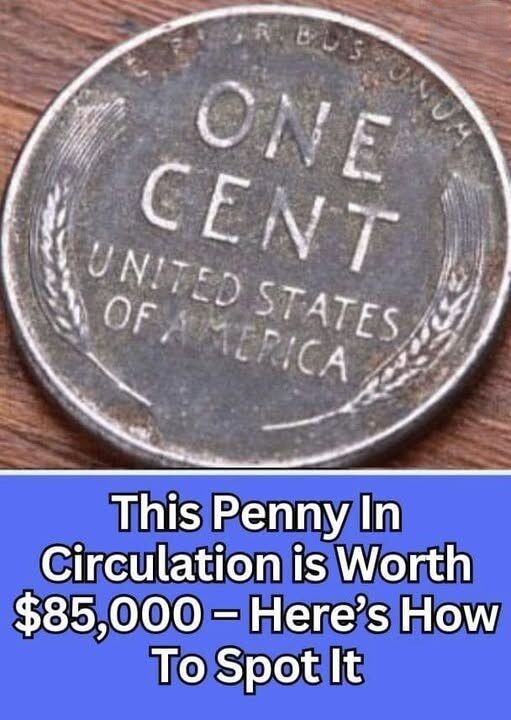
Meta Description: Discover the story of the 1943 copper wheat penny, a rare coin worth up to $85,000. Learn how to spot it, avoid counterfeits, and explore other valuable pennies that might be hiding in your change.
Introduction: A Penny That Could Change Your Life
Most of us hardly pay attention to pennies. They pile up in jars, sit in our cars, or get tucked away in drawers without much thought. But what if one of those small coins could actually be worth as much as a luxury car? For some lucky people, this dream has already come true.
Among the most remarkable finds in U.S. coin history is the 1943 copper wheat penny. Unlike ordinary pennies, this one can sell for up to $85,000 at auction. Its existence is the result of a fascinating historical mistake, and it remains one of the most coveted treasures for collectors.
This article will guide you through the story of this rare penny, how to identify it, its value, and what to watch out for to avoid fakes.
The Historical Story Behind the 1943 Copper Penny
During World War II, the United States faced a shortage of copper. This metal was essential for producing military supplies such as bullets and shell casings. To conserve copper, the U.S. Mint decided that pennies minted in 1943 would be made from zinc-coated steel instead.
These coins, called steel cents, looked silver instead of copper and were slightly magnetic. Billions were produced and circulated widely.
But due to a minting error, a small number of leftover copper planchets (coin blanks) from 1942 accidentally went through the presses in 1943. These became the legendary 1943 copper wheat pennies—coins that were never supposed to exist.
Rarity and Value of the 1943 Copper Penny
The rarity of this coin is astounding. Experts estimate that fewer than 40 genuine 1943 copper pennies exist today, across the Philadelphia, Denver, and San Francisco mints.
Because of this, their auction value is sky-high:
- Uncirculated (mint state) examples have sold for up to $85,000.
- Circulated coins often sell for $60,000 or more.
- Even worn coins remain incredibly valuable compared to their one-cent face value.
How to Identify a Genuine 1943 Copper Penny
If you think you might have one of these rare coins, here are the steps to check:
1. Look at the Date
Check if your penny is from 1943. If so, continue examining it.
2. Check the Color
A copper penny will have its familiar reddish-brown hue, not the grayish tone of the steel cents.
3. Test with a Magnet
Steel pennies from 1943 will stick to a magnet. A genuine copper penny will not.
4. Weigh the Coin
- A copper penny weighs 3.11 grams.
- A steel penny weighs about 2.7 grams.
5. Get Professional Authentication
The final step is sending your coin to a reputable grading service like PCGS or NGC. They will confirm whether it is authentic and provide an official grade that determines its market value.
Beware of Counterfeits
Because of its fame, the 1943 copper penny is one of the most faked coins in history. Common scams include:
- Altering the 8 in a 1948 penny to look like a 3.
- Copper-plating a steel 1943 penny to mimic the rare copper version.
To avoid being tricked, never rely on appearances alone. Always use the magnet test and consult a professional.
Why This Coin Matters in History
Beyond its monetary value, the 1943 copper penny is a symbol of sacrifice and change during World War II. Its existence reminds us of how even small resources were redirected to help the war effort.
For collectors, it’s not just about the money—it’s about owning a piece of American history.
Other Rare Pennies Worth Collecting
While the 1943 copper penny is the most famous, there are other pennies that hold significant value:
- 1909-S VDB Lincoln Cent – Rare due to limited mintage and the designer’s initials.
- 1955 Doubled Die Penny – A striking error coin with doubled lettering.
- 1969-S Doubled Die Penny – Another rare error highly prized by collectors.
- 1972 Doubled Die Obverse Penny – Not as rare, but still collectible.
These coins can be worth hundreds or even thousands of dollars.
Tips for Beginner Coin Collectors
If you’re new to coin collecting, here’s how to get started safely:
- Search your change – You never know what you might find.
- Learn coin grading basics – Condition plays a major role in value.
- Use proper storage – Keep coins in protective holders.
- Rely on trusted dealers – Avoid scams by working with professionals.
- Stay curious – Coin collecting is both a hobby and a way to preserve history.
The Excitement of Hidden Treasure
Many inspiring stories exist of people stumbling across rare coins:
- A coin jar at a flea market that contained a valuable piece.
- An inherited collection that turned out to include rare finds.
- A child sorting through pennies who uncovered a coin worth thousands.
These stories fuel the passion of collectors everywhere.
Conclusion
The 1943 copper wheat penny is more than just a coin. It’s a story of history, rarity, and the unexpected value that can be found in everyday life.
While most pennies you encounter will be ordinary, this extraordinary coin proves that treasures sometimes hide in plain sight. The next time you empty your pockets or roll spare change, take a closer look—you might be holding a small fortune without even knowing it.



